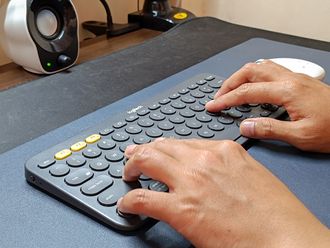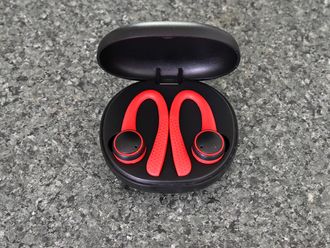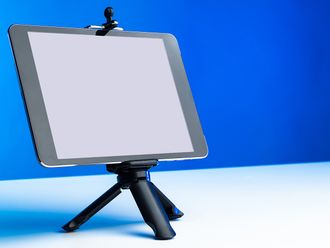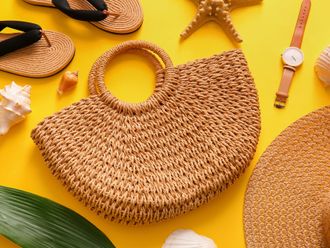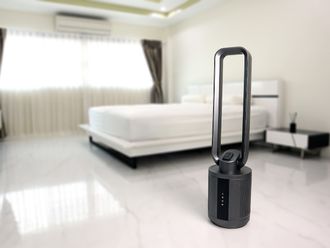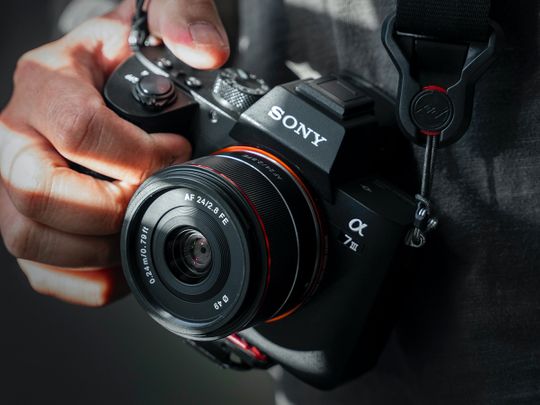
No doubt, DSLRs (digital single-lens reflex cameras) have left an indelible mark in the world of photography. It's probably why seasoned photographers hesitate to adopt newer technology, having heavily invested in pricey lenses over the years. Others do gravitate towards the lighter, intuitive mirrorless camera, a worthy contender for professional shooting.
DSLR vs. Mirrorless Camera: Which is better?
Mirrorless cameras are an excellent choice for someone just starting out. First marketed in 2008, these cameras gradually rose to popularity for functioning slightly differently (and weighing much less) than DSLRs.
A DSLR has a chunkier form factor due to the mirrors it houses in its body. When the light enters the lens, these mirrors redirect it to the optical viewfinder, the 'peephole' through which we look to frame our shot. Once the photographer is ready to click, the main mirror lifts out of the way to reveal the image sensor, allowing the light to hit it.
A mirrorless camera lacks this mirror mechanism completely, true to its name. Instead, the light hits the image sensor directly without any moving parts, says Devadasan K. P., Chief Visual Editor at Gulf News, who has over 24 years of experience in photojournalism.

Another difference worth noting is the viewfinder itself. DSLR models show you what the actual image looks like through their optical viewfinders. On mirrorless cameras, however, an electronic viewfinder (EVF) lets you adjust the exposure and other settings in real-time, before clicking the picture. This saves you time and multiple redos.
Our photography expert tells us that beginners would find a mirrorless camera easier to use and carry around. Newer models offer higher resolution sensors, and some budget variants even film better quality videos, as mirrorless technology improves with every release. They're also brilliant at clicking more frames per second, which comes in handy for action burst shots.
Though, it's no secret that some professionals still prefer the chunky feel and reliable battery life of a DSLR. Still, the latest mirrorless cameras in the market have impressively closed the gap in various features.
Based on expert recommendations and user reviews, we've picked out the best mirrorless cameras below that you can instantly shop on Amazon. Get a Prime membership to snag free, fast delivery on eligible cameras.
1. Best Overall: Sony Alpha 7 IV Full-Frame Mirrorless Interchangeable Lens Camera
Pros
- Has a 33MP full-frame sensor
- Uses the same BIONZ XR image processor found in Alpha 1 and Alpha7S III models
- 10 preset filters to set the mood
- AI-enabled autofocus
- Active Mode activates camera's stabilisation unit, gyro sensors and more
Cons
- Expensive, even without lens
- Only clicks 10 frames per second
The Alpha 7 IV flagship camera by Sony features a full-frame sensor. The Exmor R CMOS sensor captures low-noise 33-megapixel images, perfect for subjects in dimmer environments and those that need a wider field of view. This mirrorless camera does a bit of everything, from indoor portraits to landscapes. A set of 10 Creative Look presets in-camera quickly adds filters to your images and videos, without the need for post-editing. As for video recording, you can shoot up to 4K resolution at 60p, and produce even more stable results with the camera's Active Mode. The Alpha 7 IV carries S-Cinetone, too, a colour support that captures skin tones with a quality similar to that of the Cinema Line cameras. More convenient features for the photographer are the AI-based real-time eye autofocus and tracking, which can be easily controlled via the touchscreen LCD of the camera. Reviews call the results stunning and speak of groundbreaking performance in both still and moving images.
Bonus: Buy with 0% instalments and pay Dh775.47 for 12 months with select banks.
2. Best for Beginners: Fujifilm X-T30 II + XC15-45mm, Black
Pros
- 26.1MP image sensor
- Clicks up to 30 frames per second
- Offers 18 film simulations for in-camera editing
- Comes with an XC15-45mm lens
Cons
- No internal stabiliser
The Fujifilm X-T30 II carries the smaller APS-C (Advanced Photo System type-C) sensor, as opposed to a full-frame. Ideal for sports and action photography, this camera form factor gets closer to the subject without sacrificing any pixels. The accompanying XC15-45mm zoom lens covers the focal length equivalent of a full-frame, from 23mm to 69mm, so expect to capture close-up shots of wildlife. Its imaging sensor has 26.1MP, which films 4K videos at 30p. Much like our Sony pick, this mirrorless camera comes with 18 'film simulations' that reproduce colours and tones from the brand's popular analogue films. Its EVF and LCD touchscreen displays live adjustments to the grain texture, colour depth, clarity, sharpness and much more. There's also face/eye detection autofocus, low-light autofocus and tracking autofocus. Enjoy up to 30 frames per second with the electronic shutter. Beginners in the reviews praise the classic vintage look of the camera. They love how it still delivers professional results, despite being lightweight and compact. Do note, however, that there's no internal stabiliser for videos.
Bonus: Buy with 0% instalments and pay Dh324.92 for 12 months with select banks.
3. Best Travel Camera: Nikon Z50 With 16-50mm Lens
Pros
- OLED electronic viewfinder
- Takes 120fps videos in 1080p
- Fast shutter speed
- Built-in Wi-Fi and Bluetooth
- Comes with 16-50mm lens
Cons
- No in-body stabilisation
Another APS-C sensor camera, the Nikon Z50 is a pocket-friendly investment. Our selection comes with a 16-50mm lens that goes well with wide angles and portraits. The mirrorless camera features a 2.36m-dot OLED viewfinder for the best previews, and its LCD screen flips down, instead of out, making it convenient for group selfies. The best part is that while the Z50 films at 4K ultra-high definition, you can get smooth 120fps frame rates if you shoot in the 1080p full HD resolution. The 20.9-megapixel sensor operates on a robust EXPEED 6 processor that improves low-light shooting. As you're fine-tuning your shots on the LCD screen or in the EVF, apply Nikon's 20 picture controls and 10 special effects in real-time. Take the Nikon Z50 to events, games and the park, to click pictures in complete silence using the Silent Photography Mode. Most reviewers opt for this model as their travel camera because of its light weight. They attest to the depth of field and find the fast shutter speed perfect for nature photography. Others point out the built-in Wi-Fi and Bluetooth for a quick transfer of media.
Bonus: Buy with 0% instalments and pay Dh274.92 for 12 months with select banks.
4. Best Value for Full-Frame Sensor: Canon EOS R6 Mirrorless Camera Body
Pros
- 20.1MP full-frame sensor
- OLED viewfinder
- Takes up to 510 pictures on a single charge
- Has autofocus tracking for animals, eyes, head, birds and more
- Built-in image stabiliser
Cons
- Doesn't include a lens bundle
The Canon EOS R6 has a 20.1MP full-frame sensor with excellent low-light performance. Like the Sony A7 IV, this mirrorless camera comes with an in-body five-axis image stabiliser for reduced shaking. Its Dual Pixel CMOS AF II system is backed by artificial intelligence, meaning advanced subject recognition, even for fast-moving birds or pets. The EVF is a superb 3.69-dot OLED that refreshes at up to 120fps, accompanied by a touchscreen LCD screen. In the LCD power-saving mode, you can take up to 510 pictures on a single charge. Longtime fans of Canon attest to the colouring, which looks fantastic in both videography and photography. They also love dual recording on the two SD card slots. Note that it arrives without a lens bundle.
Bonus: Buy with 0% instalments and pay Dh729.08 for 12 months with select banks.
5. Best for Vlogging: Panasonic LUMIX G100 4K Mirrorless Camera
Pros
- Lightweight at 345 grams (only body)
- Frame markers for social media aspect ratios
- Instant photo transfer via a dedicated button
- Shoots 4K videos at this price
- Comes with a tripod and a 12-32mm lens
Cons
- Only has electronic stabilisation
Lauded as the vlogging camera to go for, the Panasonic Lumix G100 is designed for content creators. It has all the bells and whistles of its pricier counterparts - from the five-axis image stabiliser to the built-in Wi-Fi and Bluetooth support. Thanks to the even smaller 20.3MP photo sensor, micro four thirds (MFT), this mirrorless camera is super compact. It shoots 4K video at 30p and has optimised smartphone connection and a 360-degree internal mic that makes one-handed recording a breeze. In-camera recording settings let you slow down your video by 4x and speed it up by 8x, without post-editing on the laptop. For GRWM (get-ready-with-me) vlogs, flip the LCD screen 180 degrees to frame yourself perfectly. There's even a vertical frame marker for clips that are better suited for TikTok and Instagram Reels. Once done, click the Send Image button on the camera to transfer via Bluetooth instantly - no cables involved. More good news is that our pick comes with a grip tripod for long, on-the-go shoots, and a 12-32mm lens to get you started right out of the box. The only drawback is that a 1080p video recording stops shooting after 20 minutes, note reviews.
Bonus: Buy with 0% instalments and pay Dh200.30 for 12 months with select banks.
Our recommendations are independently chosen by Gulf News editors. If you decide to shop through links on our website, we may earn an affiliate commission, as we are part of Amazon Services LLC Associates Program.


